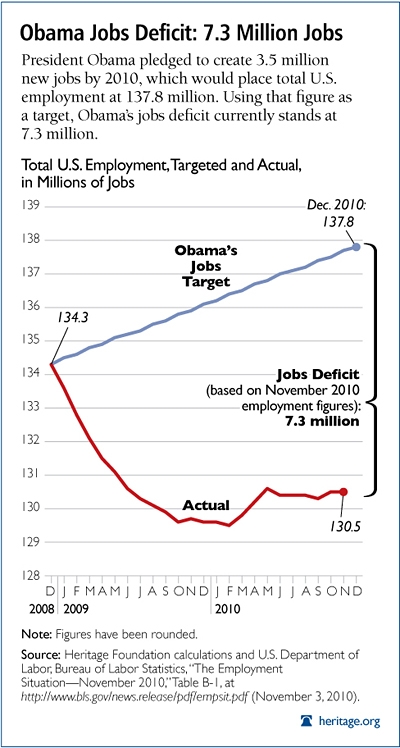Obama’s November Jobs Deficit One More Reason to Extend Bush Tax Cuts: "
“You are what your record says you are.” So says Bill Parcells, three-time Super Bowl–winning coach. Professional sports, athletes, coaches, and commentators can spin the numbers with the best of politicians, but in the end you are what your record says you are. The record on the first two years of President Obama’s economic policies is pretty dismal: publicly issued national debt up $2.9 trillion, unemployment rate jumping to 9.8 percent, and Obama’s personal metric—the Obama jobs deficit—a lofty 7.3 million workers.
The Obama Jobs Deficit
President Obama promised during the 2008 campaign (and after) that under his policies the economy would create millions of new jobs by the end of 2010. Well, we’ve reached the end of 2010. He also insisted that he be held accountable for these results. The Obama jobs deficit, which stands at 7.3 million jobs, measures the extent to which he has failed to deliver on his promised job creation. And as we saw in the midterm elections, his allies in Congress, governors’ mansions, and state legislations across the country were held accountable, paying a heavy price for Obama’s failure to perform.
The President’s original target for jobs creation set during the campaign in the fall of 2008 was 2.5 million jobs. But as employment fell at the end of 2008, he increased the employment target by 1 million to 3.5 million jobs. At the time, employment stood at about 135.1 million, according to the Department of Labor’s most commonly used measure. This establishes the current Obama jobs target at 138.6 million. According to the latest jobs report, total U.S. employment stood at 130.5 million in November, which means that the cumulative Obama jobs deficit—the difference between the end target and the current employment level—stands at 7.3 million. (The actual figure is 7.58 million—138.58 million in December 2010 minus 131 million in November 2009.)
Obama Tax Hike Weakening Job Creation
Despite a succession of costly failures masquerading as economic stimulus, the economy is finally showing tepid signs of sustained recovery. Today’s jobs report’s job growth of a paltry 39,000 is the latest evidence. The report is even weaker than it first appears, because all of the increase in net employment can be traced to an increase in temporary help services. An increase in temporary help service employment is of course welcome for those who have these jobs, and it is a natural early step in the recovery process, but it also reinforces that the recovery remains very weak.
As we have seen yet again, the federal government cannot stimulate the economy in the short term by increased borrowing and reshuffling total demand through wasteful deficit spending. But government can stimulate the economy by improving incentives and the general economic environment. The massive tax hike President Obama has proposed—and Speaker Nancy Pelosi (D–CA) is threatening to unleash on the economy by allowing the 2001/2003 tax relief to expire at the end of this year—goes in the diametrically opposite direction and is already draining the vitality from the economy and job creation.
Nor is this just any tax hike. Seemingly bent on perpetuating joblessness, Obama and his allies are seeking to raise some of the most damaging taxes possible. They seek to raise tax rates on the investors who are needed to provide seed corn for new businesses and on small businesses that use this seed corn to spur innovation and job growth. Foolish in the best of times, raising these economically punishing taxes in the face of high unemployment is indefensible.
"
No comments:
Post a Comment